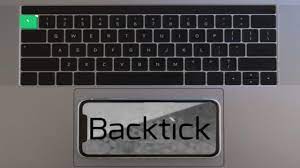What is a Backtick?

A backtick is a type of quotation mark used in computer programming. It looks like this: `.
The backtick is also known as an “open quote” or “left quote.” In most programming languages, the backtick is used to create strings. For example, in the C programming language, a string might be written like this:
“This is a string”
The backtick is also used in some programming languages to create “escaped” characters. For example, in the C programming language, the backtick is used to create the newline character:
“This is a string\
The backtick is also used in some programming languages for “command substitution.” This is a way to run a command and insert its output into a string. For example, in the Bash shell, you might use command substitution to create a string that contains the current date and time:
“The current date and time is: `date`”
The backtick is also used in some programming languages for “variable substitution.” This is a way to insert the value of a variable into a string. For example, in the PHP programming language, you might use variable substitution to create a string that contains the value of a variable:
“The value of the variable is: $foo”
2. How to Use Backtick
A backtick is a symbol (`) used to enclose a piece of code or text. When used in code, a backtick tells the computer to treat the enclosed code as if it were a separate entity. This can be useful for creating shortcuts or for making text stand out.
In text, a backtick can be used to create a “block quote.” This is where the author sets off a quotation by starting it on a new line and enclosing it in backticks. The block quote will then be indented from the rest of the text.
Here is an example of how a backtick can be used in code:
“`
var x = “This is a string”;
“`
And here is an example of how a backtick can be used in text:
> “This is a quote,” he said. “It is set off from the rest of the text by being enclosed in backticks.”
When creating a block quote, it is important to make sure that the text is actually quoted. If you set off a piece of text with backticks but it is not a quote, your readers may think you are being misleading.
Here are some other ways you can use backticks:
– To create an inline code block, enclose your code in backticks. This can be useful for showing code snippets in your posts or for highlighting words that might be technical jargon.
– To create a “fenced code block,” start your code block with a row of three backticks and end it with a row of three backticks. This can be useful for showing longer code snippets in your posts.
– To create a strikethrough, enclose your text in two tildes (~~). This can be useful for indicating that something is no longer relevant or for showing corrections.
– To create a superscript, enclose your text in two carets (^^). This can be useful for showing trademark symbols or for indicating that something is an abbreviation.
– To create a subscript, enclose your text in two underscores (__).
3. Backtick Tips and Tricks
A backtick (`) is a type of quotation mark used in various programming languages. It is also known as an grave accent or open quote. In some languages, the backtick is used as a delimiter for specifying template literal expressions.
Here are three tips and tricks for using backticks in your code:
1. Use backticks to enclosed code blocks in markdown
If you want to create a code block in markdown, you can use backticks to do so. For example, let’s say you want to create a code block for a Java program:
“`java
public static void main(String[] args) {
System.out.println(“Hello, world!”);
}
“`
2. Use backticks to create inline code snippets
In addition to creating code blocks, you can also use backticks to create inline code snippets. This can be useful for highlighting a particular word or phrase within a sentence. For example:
The `main()` method is the entry point for a Java program.
3. Use backticks to escape characters
In some cases, you may need to escape characters within a string. This can be done by using a backtick followed by the character you want to escape. For example:
The backtick character is used to escape other characters.




